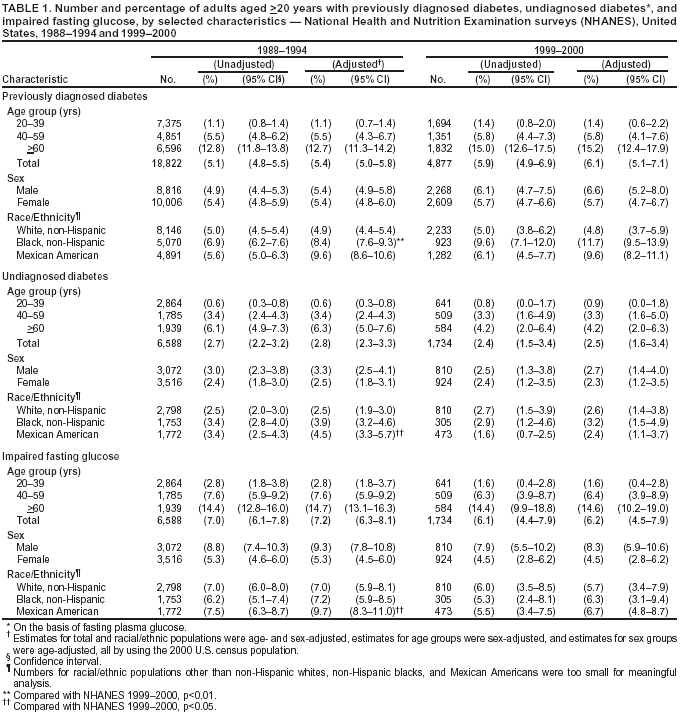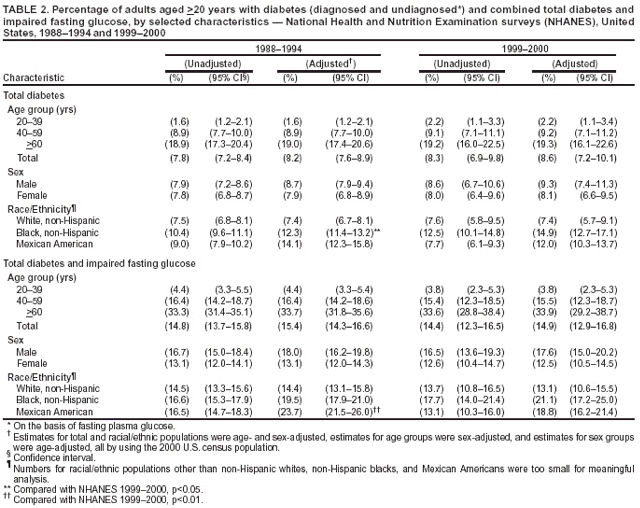 |
|
|
|
|
|
|
| ||||||||||
|
|
|
|
|
|
|
||||
| ||||||||||
|
|
|
|
|
|
Persons using assistive technology might not be able to fully access information in this file. For assistance, please send e-mail to: mmwrq@cdc.gov. Type 508 Accommodation and the title of the report in the subject line of e-mail. Prevalence of Diabetes and Impaired Fasting Glucose in Adults --- United States, 1999--2000Diabetes and its complications are major causes of morbidity and mortality in the United States and contribute substantially to health-care costs. Data from the National Health Interview Survey (NHIS) and the Behavioral Risk Factor Surveillance System (BRFSS) have documented steady increases in the prevalence of diabetes (1,2). However, these surveys rely only on self-reports of previously diagnosed diabetes and cannot measure the prevalence of undiagnosed diabetes. The change in prevalence demonstrated by these data might reflect other factors such as enhanced detection rather than true increases. The National Health and Nutrition Examination surveys (NHANES) are the only nationally representative surveys that examine both diagnosed and undiagnosed diabetes. During 1976--1980 (NHANES II) and 1988--1994 (NHANES III), the overall combined prevalence of diabetes (diagnosed and undiagnosed on the basis of fasting glucose) increased (3). This report presents data on prevalence of diagnosed and undiagnosed diabetes and impaired fasting glucose from NHANES 1999--2000 and NHANES III (1988--1994). The findings indicate that diabetes and impaired fasting glucose continue to affect a major proportion of the U.S. population. An estimated 29 million (14.4%) persons aged >20 years had either diagnosed diabetes, undiagnosed diabetes, or impaired fasting glucose; 29% of diabetes cases were undiagnosed. Persons can reduce their risk for diabetes through weight management and physical activity. NHANES 1999--2000 (4) was designed to be nationally representative of the U.S. civilian, noninstitutionalized population on the basis of a complex, multistage probability sample. Survey participants were interviewed in their homes and subsequently received physical examinations in mobile examination centers. The household interview was completed by 81.9% of eligible subjects, including 4,880 persons aged >20 years. Persons were asked if, other than during pregnancy for women, a doctor or a health-care professional had ever told them they had diabetes. From these responses, 480 persons aged >20 years were classified as having previously diagnosed diabetes. Of 1,996 persons aged >20 years without diagnosed diabetes who were randomly assigned to a morning examination session and who fasted 9 to <24 hours, plasma glucose values were obtained for 1,734 (87%). Plasma glucose was measured by using a hexokinase enzymatic method with a coefficient of variation of <2.5% during the 2 years of the survey. Diagnostic criteria of the American Diabetes Association (ADA) were used to categorize persons without previously diagnosed diabetes as to whether they had undiagnosed diabetes (fasting plasma glucose >126 mg/dL) or impaired fasting glucose (fasting plasma glucose 110 to <126 mg/dL) (5). Findings from NHANES 1999--2000 were compared with those from NHANES III (1988--1994), which used similar procedures (3). Sampling weights for the interviewed sample and the morning plasma glucose sample were incorporated to provide estimates that were representative of the U.S. population. Prevalence based on fasting glucose in the morning sample of persons without diagnosed diabetes was adjusted as described previously (6) so estimates based on these data would represent the total U.S. population. Age- and sex-adjusted rates were computed by the direct method by using U.S. 2000 Census data, with age categories of 20--39, 40--59, and >60 years. Replicated variance estimation methods were used to calculate the standard errors, accounting for both the complex sample design and the use of both interview and morning examination sample data in combination. Two sample t-tests were used to test differences in proportions. The estimated unadjusted prevalence of previously diagnosed diabetes in adults aged >20 years during 1999--2000 was 5.9% (95% confidence interval [CI] = 4.9--6.9) (Table 1), representing 11.8 million (95% CI = 9.8--13.8 million) U.S. adults. The prevalence increased by age, reaching 15.0% (95% CI = 12.6--17.5) among persons aged >60 years. Rates were similar by sex. The adjusted prevalence was significantly lower in non-Hispanic whites compared with Mexican Americans and non-Hispanic blacks. The unadjusted prevalence of undiagnosed diabetes based on fasting glucose in adults aged >20 years was 2.4% (95% CI = 1.5--3.4) during 1999--2000, representing 4.9 million (95% CI = 3.0--6.8 million) U.S. adults. Prevalence increased slightly with age and was similar in men and women. Rates were similar by race/ethnicity. Combining diagnosed and undiagnosed diabetes (Table 2), the unadjusted prevalence of total diabetes during 1999--2000 was 8.3% (95% CI = 6.9--9.8), affecting an estimated 16.7 million (95% CI = 13.8--19.6 million) persons aged >20 years. Differences in prevalence by age, sex, and race/ethnicity mirrored those for diagnosed diabetes. During 1999--2000, the proportion of total diabetes that was undiagnosed was 29% (95% CI = 21%--38%). The overall prevalence of diagnosed diabetes, undiagnosed diabetes, total diabetes, and the overall proportion of total diabetes that was undiagnosed did not change significantly from 1988--1994 to 1999--2000. Overall prevalence of impaired fasting glucose during 1999--2000 was 6.1% (95% CI = 4.4--7.9) (Table 1), representing 12.3 million (95% CI = 8.8--15.8 million) persons aged >20 years. Rates increased with age, were higher in men (7.9%) (95% CI = 5.5--10.2) than in women (4.5%) (95% CI = 2.8--6.2), and were similar by race/ethnicity. The overall decrease in prevalence observed from 1988--1994 to 1999--2000 was not statistically significant. During 1999--2000, the combined unadjusted prevalence of total diabetes and impaired fasting glucose in adults aged >20 years was 14.4% (95% CI = 12.3%--16.5%) (Table 2), representing 29.0 million (95% CI = 24.8--33.2 million) persons. Prevalence increased with age, reaching 33.6% (95% CI = 28.8%--38.4%) by age >60 years. Adjusted prevalence was significantly lower in women than in men, and in non-Hispanic whites compared with non-Hispanic blacks and Mexican Americans. Rates were similar in 1988--1994 and 1999--2000. Reported by: CC Cowie, PhD, National Institute of Diabetes and Digestive and Kidney Diseases, Bethesda; KF Rust, PhD, Westat, Inc., Rockville; D Byrd-Holt, Social & Scientific Systems, Inc., Silver Spring, Maryland. MS Eberhardt, PhD, S Saydah, PhD, National Center for Health Statistics; LS Geiss, MA, MM Engelgau, MD, ES Ford, MD, EW Gregg, PhD, National Center for Chronic Disease Prevention and Health Promotion, CDC. Editorial Note: Diabetes continues to affect a substantial proportion of U.S. adults. On the basis of NHANES 1999--2000, a total of 8.3% of persons aged >20 years had either diagnosed or undiagnosed diabetes, and this percent increased to 19.2% for persons aged >60 years. Men and women were affected similarly by diabetes. However, non-Hispanic blacks and Mexican Americans had a disproportionately high prevalence compared with non-Hispanic whites. Impaired fasting glucose increases the risk for diabetes and is associated with other cardiovascular risk factors (7). In 1999--2000, an additional 6.1% of adults had impaired fasting glucose (a rate similar in magnitude to the prevalence of diagnosed diabetes), increasing to 14.4% for persons aged >60 years, with men affected more than women. Overall, an estimated 14.4% of the U.S. population aged >20 years and 33.6% of those aged >60 years had either diabetes or impaired fasting glucose.The findings in this report are subject to at least two limitations. First, the substantially smaller sample size of NHANES 1999--2000 limits the precision of estimated prevalences and the statistical power to detect changes in these estimates between the surveys. Second, because an oral glucose tolerance test (OGTT) was not performed in NHANES 1999--2000, this survey does not capture the additional proportion of persons with abnormal postload glucose tolerance and normal fasting glucose levels. NHANES III (1988--1994) indicated that total glucose intolerance was 36% higher based on OGTT data (3). The findings in this report indicate that the prevalence of diabetes, either diagnosed or undiagnosed, and impaired fasting glucose did not appear to increase substantially during the 1990s. Estimates of diagnosed diabetes in NHANES 1999--2000 are similar in magnitude to those from NHIS and BRFSS during the same years. The apparent lack of increase in prevalence is unexpected in light of the increasing prevalence of obesity and overweight in U.S. adults documented by the NHANES surveys (8). Although a potential change in the ratio of undiagnosed to total diabetes prevalence would be an important finding, the observed differences are not statistically significant. Further investigation with additional years of NHANES data will be necessary to provide more precise estimates. In addition, the potential impact on the prevalence estimates of the change in diagnosis of diabetes adopted by the ADA in 1997 (5) should be accounted for, along with changes in demographic characteristics and overweight. Recent trials have documented that lifestyle modification (i.e., weight management and increased physical activity) reduces the risk for developing diabetes among persons with impaired glucose tolerance (9). Other clinical trials and studies have demonstrated that the risk for diabetic complications is reduced substantially by blood glucose, blood pressure, and blood lipid control (10). These messages should continue to be communicated through education and outreach activities such as the "Steps to a HealthierUS" by the U.S. Department of Health and Human Services (http://www.healthierus.gov/steps), and the "Small Steps, Big Rewards" (http://ndep.nih. gov/get-info/dpc.htm) and "Control the ABCs of Diabetes" (http://ndep.nih.gov/control/control.htm) campaigns of the National Diabetes Education Program. References
Table 1  Return to top. Table 2  Return to top.
Disclaimer All MMWR HTML versions of articles are electronic conversions from ASCII text into HTML. This conversion may have resulted in character translation or format errors in the HTML version. Users should not rely on this HTML document, but are referred to the electronic PDF version and/or the original MMWR paper copy for the official text, figures, and tables. An original paper copy of this issue can be obtained from the Superintendent of Documents, U.S. Government Printing Office (GPO), Washington, DC 20402-9371; telephone: (202) 512-1800. Contact GPO for current prices. **Questions or messages regarding errors in formatting should be addressed to mmwrq@cdc.gov.Page converted: 4/7/2004 |
|
|||||||
This page last reviewed 4/7/2004
|